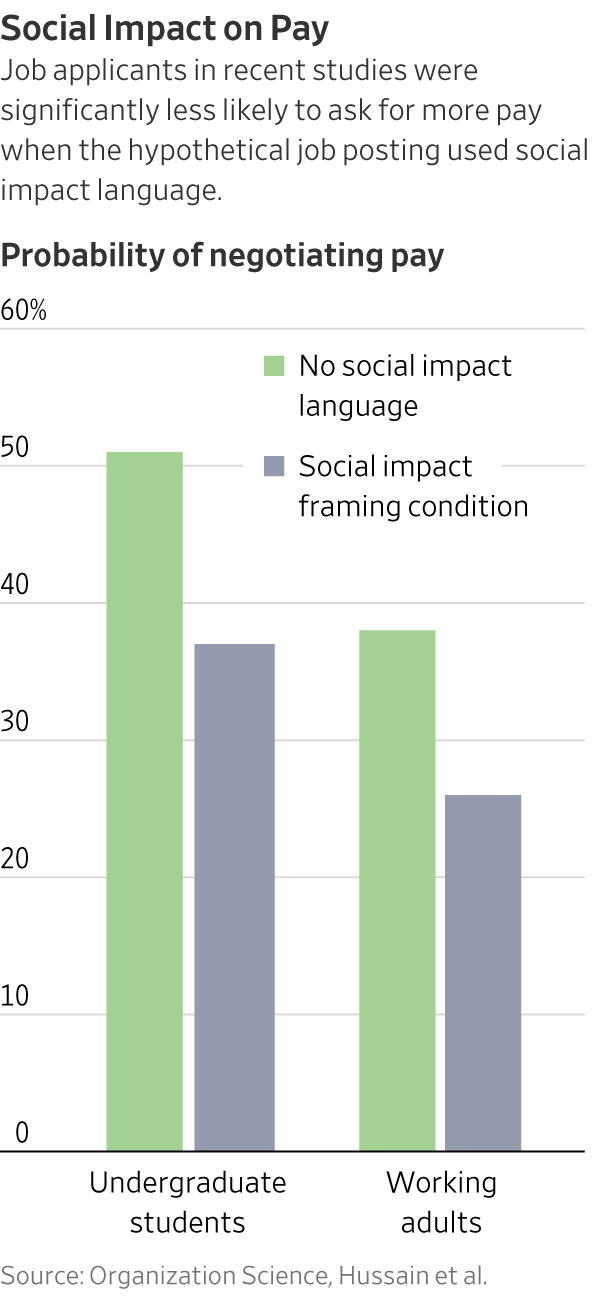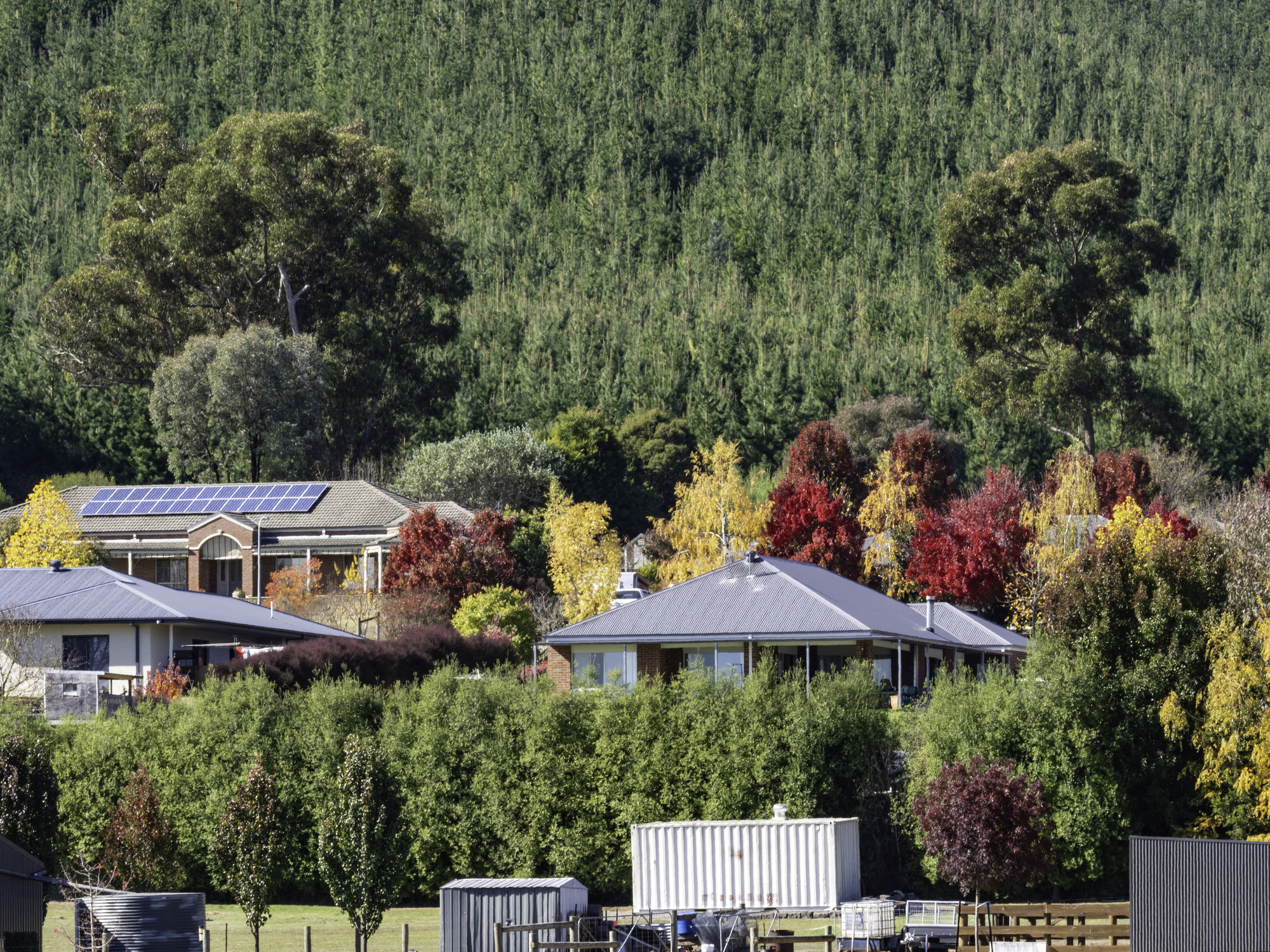Job Applicants Can Support a Company’s Mission—and Still Ask for More Money
Research suggests that would-be employees fear that negotiating for a higher salary will make them look selfish
Want to work for a company that says it makes the world a better place? Be careful—you might feel guilted out of asking for higher pay.
Job postings today are peppered with language promoting an organisation’s mission, its purpose and the importance of making an impact. But those positive messages can have a chilling effect on applicants. In several studies, my colleagues and I found that the social messages in job postings make people think it would be a bad idea to ask for more money. They fear that the managers will think of them as selfish, or that company values make salary requests taboo.
Great reluctance
To be clear, the problem isn’t that companies advertise broad social initiatives—known as social impact framing—or that they want employees to genuinely care about the work itself. Longstanding research has even shown that corporate social programs can benefit employees, who enjoy a greater sense of motivation and meaningfulness when their work demonstrably makes a positive difference.
But this notion of higher purpose can make applicants wary of seeking higher pay.
My colleagues and I tested this idea over five experiments that measured how applicants handled salary negotiations with different companies: Some were described with phrases such as “mission orientation,” “higher purpose” and “giving back,” while others weren’t. We didn’t say whether the company was a nonprofit, engaged in charitable giving or could afford higher wages; our focus was on the language or framing used to describe the work, regardless of the company’s business model.

The results were remarkably consistent. Across the studies, job candidates exposed to social impact framing told us the company would see it as crass or inappropriate to ask for material rewards like a higher salary—so they avoided negotiating for more.
In the first study, 392 participants provided open-ended responses as to whether they would ask for higher pay at hypothetical companies, along with their rationale. Those who were given social impact framing were 32 percentage points less likely to say “yes” to negotiating. In addition, the group who gave negative responses was more than twice as likely as the control group to use phrases such as “doing so would be taboo,” “make you look selfish if you asked,” and “would likely make the organization less interested in hiring me.”
In the second and third studies, we tested the effect in real-world contexts. In one, we asked 438 undergraduate students whether they would ask for more money for a purportedly real on-campus job opportunity. In the other, we asked 1,525 online workers recruited from a crowdsourcing marketplace to bid for a purported writing-related task.
In each case, the odds of negotiating were approximately 42 percentage points lower when the work was framed in social impact terms. Survey responses showed that this was driven by workers’ perceptions that they would be violating the organisation’s expectations for employee motivation by showing interest in higher pay.
Our fourth study replicated the effects above, while our fifth study showed that effects held across a range of industries—from education to financial services.
A matter of perception
Why did this happen? We theorise that the applicants assumed that managers and companies had motivation purity bias—thinking that employees who are interested in a job’s material rewards care less about the work itself. And, indeed, previous research has shown that this bias does affect managers’ decisions.
That means few applicants want to be seen as the person who gives priority to money over more lofty, altruistic goals. You either love the work itself and want to help others or care about material rewards like higher pay. It can’t be both.
But that attitude is simply romanticising. Research shows that people often do their jobs better when they get a combination of extrinsic rewards like high salary and intrinsic ones like idealism about a mission.
The consequences of holding back on salary requests can be huge. Previous research has shown that fear of asking for even a small increase in starting pay can cost people hundreds of thousands of dollars over the course of a career. For companies, skimping on pay because of misguided beliefs can lead to missed opportunities to boost performance and productivity.
How to overcome the bias? Employees should do research on companies to see how the businesses react to salary requests. For their part, companies can create greater pay transparency, use objective criteria to set salary and train managers to watch out for bias.
Passion for work is wonderful. But we shouldn’t romanticise it as the only legitimate reason to take a job.
 Copyright 2020, Dow Jones & Company, Inc. All Rights Reserved Worldwide. LEARN MORE
Copyright 2020, Dow Jones & Company, Inc. All Rights Reserved Worldwide. LEARN MORE
This stylish family home combines a classic palette and finishes with a flexible floorplan
Just 55 minutes from Sydney, make this your creative getaway located in the majestic Hawkesbury region.
As Paris makes its final preparations for the Olympic games, its residents are busy with their own—packing their suitcases, confirming their reservations, and getting out of town.
Worried about the hordes of crowds and overall chaos the Olympics could bring, Parisians are fleeing the city in droves and inundating resort cities around the country. Hotels and holiday rentals in some of France’s most popular vacation destinations—from the French Riviera in the south to the beaches of Normandy in the north—say they are expecting massive crowds this year in advance of the Olympics. The games will run from July 26-Aug. 1.
“It’s already a major holiday season for us, and beyond that, we have the Olympics,” says Stéphane Personeni, general manager of the Lily of the Valley hotel in Saint Tropez. “People began booking early this year.”
Personeni’s hotel typically has no issues filling its rooms each summer—by May of each year, the luxury hotel typically finds itself completely booked out for the months of July and August. But this year, the 53-room hotel began filling up for summer reservations in February.
“We told our regular guests that everything—hotels, apartments, villas—are going to be hard to find this summer,” Personeni says. His neighbours around Saint Tropez say they’re similarly booked up.
As of March, the online marketplace Gens de Confiance (“Trusted People”), saw a 50% increase in reservations from Parisians seeking vacation rentals outside the capital during the Olympics.
Already, August is a popular vacation time for the French. With a minimum of five weeks of vacation mandated by law, many decide to take the entire month off, renting out villas in beachside destinations for longer periods.
But beyond the typical August travel, the Olympics are having a real impact, says Bertille Marchal, a spokesperson for Gens de Confiance.
“We’ve seen nearly three times more reservations for the dates of the Olympics than the following two weeks,” Marchal says. “The increase is definitely linked to the Olympic Games.”

Getty Images
According to the site, the most sought-out vacation destinations are Morbihan and Loire-Atlantique, a seaside region in the northwest; le Var, a coastal area within the southeast of France along the Côte d’Azur; and the island of Corsica in the Mediterranean.
Meanwhile, the Olympics haven’t necessarily been a boon to foreign tourism in the country. Many tourists who might have otherwise come to France are avoiding it this year in favour of other European capitals. In Paris, demand for stays at high-end hotels has collapsed, with bookings down 50% in July compared to last year, according to UMIH Prestige, which represents hotels charging at least €800 ($865) a night for rooms.
Earlier this year, high-end restaurants and concierges said the Olympics might even be an opportunity to score a hard-get-seat at the city’s fine dining.
In the Occitanie region in southwest France, the overall number of reservations this summer hasn’t changed much from last year, says Vincent Gare, president of the regional tourism committee there.
“But looking further at the numbers, we do see an increase in the clientele coming from the Paris region,” Gare told Le Figaro, noting that the increase in reservations has fallen directly on the dates of the Olympic games.
Michel Barré, a retiree living in Paris’s Le Marais neighbourhood, is one of those opting for the beach rather than the opening ceremony. In January, he booked a stay in Normandy for two weeks.
“Even though it’s a major European capital, Paris is still a small city—it’s a massive effort to host all of these events,” Barré says. “The Olympics are going to be a mess.”
More than anything, he just wants some calm after an event-filled summer in Paris, which just before the Olympics experienced the drama of a snap election called by Macron.
“It’s been a hectic summer here,” he says.

AFP via Getty Images
Parisians—Barré included—feel that the city, by over-catering to its tourists, is driving out many residents.
Parts of the Seine—usually one of the most popular summertime hangout spots —have been closed off for weeks as the city installs bleachers and Olympics signage. In certain neighbourhoods, residents will need to scan a QR code with police to access their own apartments. And from the Olympics to Sept. 8, Paris is nearly doubling the price of transit tickets from €2.15 to €4 per ride.
The city’s clear willingness to capitalise on its tourists has motivated some residents to do the same. In March, the number of active Airbnb listings in Paris reached an all-time high as hosts rushed to list their apartments. Listings grew 40% from the same time last year, according to the company.
With their regular clients taking off, Parisian restaurants and merchants are complaining that business is down.
“Are there any Parisians left in Paris?” Alaine Fontaine, president of the restaurant industry association, told the radio station Franceinfo on Sunday. “For the last three weeks, there haven’t been any here.”
Still, for all the talk of those leaving, there are plenty who have decided to stick around.
Jay Swanson, an American expat and YouTuber, can’t imagine leaving during the Olympics—he secured his tickets to see ping pong and volleyball last year. He’s also less concerned about the crowds and road closures than others, having just put together a series of videos explaining how to navigate Paris during the games.
“It’s been 100 years since the Games came to Paris; when else will we get a chance to host the world like this?” Swanson says. “So many Parisians are leaving and tourism is down, so not only will it be quiet but the only people left will be here for a party.”
This stylish family home combines a classic palette and finishes with a flexible floorplan
Just 55 minutes from Sydney, make this your creative getaway located in the majestic Hawkesbury region.






















